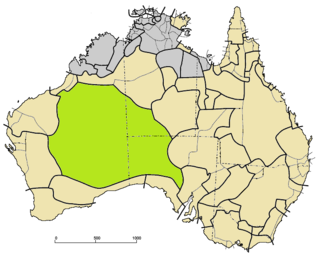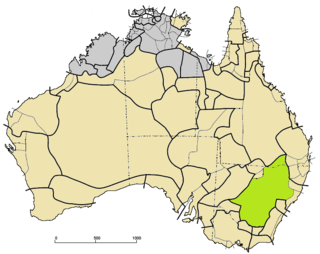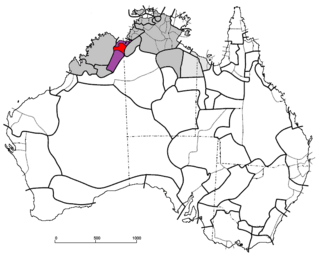An abjad is a writing system in which only consonants are represented, leaving vowel sounds to be inferred by the reader. This contrasts with other alphabets, which provide graphemes for both consonants and vowels. The term was introduced in 1990 by Peter T. Daniels. Other terms for the same concept include: partial phonemic script, segmentally linear defective phonographic script, consonantary, consonant writing, and consonantal alphabet.
Australian Aboriginal English is a cover term used for the complex, rule-governed varieties of English used by a large section of the Indigenous Australian population as a result of colonization. It is made up of a number of varieties which developed differently in different parts of Australia, and grammar and pronunciation differs from that of standard Australian English, along a continuum. Some of its words have also been adopted into standard or colloquial Australian English.

The Western Desert language, or Wati, is a dialect cluster of Australian Aboriginal languages in the Pama–Nyungan family.

Wiradjuri is a Pama–Nyungan language of the Wiradhuric subgroup. It is the traditional language of the Wiradjuri people of Australia. A progressive revival is underway, with the language being taught in schools. Wiraiari and Jeithi may have been dialects.

The Bunuban languages are a small family of Australian Aboriginal languages spoken in northern Australia. The family consists of two languages, Bunuba and Gooniyandi, which are related to each other to about the same degree that English is related to Dutch. Bunuba has about 100 speakers and Gooniyandi about 400. Both are endangered.
Walmajarri is a Pama–Nyungan language spoken in the Kimberley region of Western Australia by the Walmadjari and related peoples.

Pitjantjatjara is a dialect of the Western Desert language traditionally spoken by the Pitjantjatjara people of Central Australia. It is mutually intelligible with other varieties of the Western Desert language, and is particularly closely related to the Yankunytjatjara dialect. The names for the two groups are based on their respective words for 'come/go.'

Prior to the arrival of Europeans, Australian Aboriginal languages had been purely spoken languages, and had no writing system. On their arrival, Latin script became a standard for transcription of Australian Aboriginal languages, but the details of how the sounds were represented has varied over time and from writer to writer, sometimes resulting in a great many variant spellings of the same word or name.
Bardi is an endangered Australian Aboriginal language in the Nyulnyulan family, mutually intelligible with Jawi and possibly other dialects. It is spoken by the Bardi people at the tip of the Dampier peninsula and neighbouring islands. There are few fluent speakers in the 21st century, but efforts are being made to teach the Bardi language and culture at at least one school.

The Wunambal language, also known as Northern Worrorran, Gambera or Gaambera, is a moribund Australian Aboriginal language of Western Australia. It has several dialects, including Yiiji, Gunin, Miwa, and Wilawila. It is spoken by the Wunambal people.
Nyulnyul is an dormant Australian Aboriginal language, formerly spoken by the Nyulnyul people of Western Australia.

Miriwoong, also written Miriuwung and Miriwung, is an Aboriginal Australian language which today has fewer than 20 fluent speakers, most of whom live in or near Kununurra in Western Australia. All of the fluent speakers are elderly and the Miriwoong language is considered to be critically endangered. However, younger generations tend to be familiar with a lot of Miriwoong vocabulary which they use when speaking Kimberley Kriol or Aboriginal English.
Murrinh-patha, called Garama by the Jaminjung, is an Australian Aboriginal language spoken by over 2,000 people, most of whom live in Wadeye in the Northern Territory, where it is the dominant language of the community. It is spoken by the Murrinh-Patha people, as well as several other peoples whose languages are extinct or nearly so, including the Mati Ke and Marri-Djabin. It is believed to be the most widely spoken Australian Aboriginal language not belonging to the Pama-Nyungan language family.
Nicholas Thieberger is an Australian linguist and an Associate Professor in the School of Languages and Linguistics at the University of Melbourne. He helped to establish the PARADISEC archive in 2003 and currently serves as its Director. Thieberger was the Editor of Language Documentation & Conservation (2011-2021), an academic journal which focuses on language documentation and conservation. He was elected a Fellow of the Australian Academy of the Humanities in 2021.

The Nyikina people are an Aboriginal Australian people of the Kimberley region of Western Australia.

Bunuba is an Australian Aboriginal language spoken by some 41 older Bunuba adults, most of whom live in Junjuwa, an Aboriginal community in Fitzroy Crossing in Western Australia. Bunuba is not related to the Pama-Nyungan language family that spans the majority of Australia; however, it is a relative of Guniyandi. Both are subgroups of the Bunuban language family. Bunuba consists of two dialects, 'light' and 'heavy' Bunuba.

Yawuru is a Western Nyulnyulan language spoken on the coast south of Broome in Western Australia.

The Bunuba are a group of Indigenous Australians and are one of the traditional owners of the southern West Kimberley, in Western Australia. Many now live in and around the town of Fitzroy Crossing.
The Gooniyandi, also known as the Konejandi, are an Aboriginal Australian people in the Kimberley region of Western Australia.
William Bernard McGregor is an Australian linguist and professor in linguistics at Aarhus University. He specializes in the description of mainly non-Pama-Nyungan Australian languages and does descriptive linguistic work on Gooniyandi, Nyulnyul and Warrwa, but also studies the Shua language in Africa. He works on theoretical and typological issues from within a variation of systemic functional linguistics dubbed Semiotic Grammar developed by himself.









